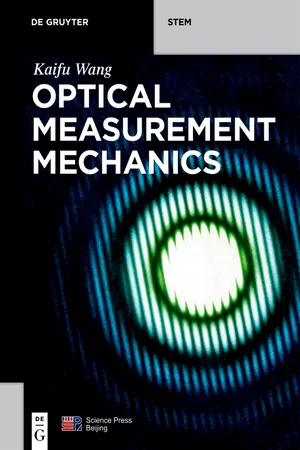
- 121 pages
- English
- ePUB (mobile friendly)
- Available on iOS & Android
eBook - ePub
Optical Measurement Mechanics
About this book
The book introduces the fundamentals of optical measurement mechanics, and discusses different types of interferometry, including (Digital) Holographic Interferometry, (Digital) Speckle Interferometry, Moiré Interferometry, Digital Image Correlation and Particle Image Velocimetry. It is an essential reference for graduate students, scientists and practitioners from both universities and research laboratories.
Frequently asked questions
Yes, you can cancel anytime from the Subscription tab in your account settings on the Perlego website. Your subscription will stay active until the end of your current billing period. Learn how to cancel your subscription.
At the moment all of our mobile-responsive ePub books are available to download via the app. Most of our PDFs are also available to download and we're working on making the final remaining ones downloadable now. Learn more here.
Perlego offers two plans: Essential and Complete
- Essential is ideal for learners and professionals who enjoy exploring a wide range of subjects. Access the Essential Library with 800,000+ trusted titles and best-sellers across business, personal growth, and the humanities. Includes unlimited reading time and Standard Read Aloud voice.
- Complete: Perfect for advanced learners and researchers needing full, unrestricted access. Unlock 1.4M+ books across hundreds of subjects, including academic and specialized titles. The Complete Plan also includes advanced features like Premium Read Aloud and Research Assistant.
We are an online textbook subscription service, where you can get access to an entire online library for less than the price of a single book per month. With over 1 million books across 1000+ topics, we’ve got you covered! Learn more here.
Look out for the read-aloud symbol on your next book to see if you can listen to it. The read-aloud tool reads text aloud for you, highlighting the text as it is being read. You can pause it, speed it up and slow it down. Learn more here.
Yes! You can use the Perlego app on both iOS or Android devices to read anytime, anywhere — even offline. Perfect for commutes or when you’re on the go.
Please note we cannot support devices running on iOS 13 and Android 7 or earlier. Learn more about using the app.
Please note we cannot support devices running on iOS 13 and Android 7 or earlier. Learn more about using the app.
Yes, you can access Optical Measurement Mechanics by Kaifu Wang in PDF and/or ePUB format, as well as other popular books in Physical Sciences & Atomic & Molecular Physics. We have over one million books available in our catalogue for you to explore.
Information
1Optical measurement mechanics fundamentals
Optical measurement mechanics (or photomechanics) is an experimental interdiscipline related to optics and mechanics. Optical measurement mechanics can be used for solving mechanical problems, such as deformation measurement, vibration analysis, nondestructive testing, etc., by employing optical techniques, such as holographic interferometry, speckle interferometry, moiré interferometry, etc.
1.1Optics
Optics is the branch of physics that is concerned with light and vision and deals chiefly with the generation, propagation, and detection of electromagnetic radiation having wavelengths greater than X-rays and shorter than microwaves.
Optics usually describes the behavior and property of light. Light is electromagnetic radiation within a certain portion of the electromagnetic spectrum and usually refers to visible light, which is visible to the human eye and is responsible for the sense of sight. Visible light has wavelengths in the range from about 400 (violet) to 760 (red) nanometers between infrared (with longer wavelengths) and ultraviolet (with shorter wavelengths).
Often, infrared and ultraviolet are also called light. Infrared light has the range of invisible radiation wavelengths froma bout 760 nm, just greater than red in the visible spectrum, to 1 mm, on the border of the microwave region. Ultraviolet light has the range of invisible radiation wavelengths from about 4 nm, on the border of the X-ray region, to about 400 nm, just beyond the violet in the visible spectrum.
1.1.1Geometrical optics
Most optical phenomena can be accounted for using the classical electromagnetic description of light. However, a complete electromagnetic description of light is often difficult to apply in practice. Therefore, simplified models are usually utilized in optics. One of the commonly used models is called geometrical optics, or ray optics. Geometrical optics treats light as a collection of light rays and describes light propagation in terms of light rays. A light ray is a straight or curved line that is perpendicular to the wavefront of light and is therefore collinear with the wave vector. A slightly more rigorous definition of light ray follows from Fermat’s principle, which states that the path taken between two points by a ray of light is the path that can be traversed in the least time. The light ray in geometrical optics is useful in approximating the paths along which light propagates in certain classes of media.
The simplifying assumptions in geometrical optics are mainly that light rays: (1) propagate in rectilinear paths as they travel in ...
Table of contents
- Cover
- Title Page
- Copyright
- Preface
- Contents
- 1 Optical measurement mechanics fundamentals
- 2 Holography and holographic interferometry
- 3 Speckle photography and speckle interferometry
- 4 Geometric moiré and moiré interferometry
- 5 Phase-shifting interferometry and phase unwrapping
- 6 Discrete transformation and low-pass filtering
- 7 Digital holography and digital holographic interferometry
- 8 Digital speckle interferometry and digital speckle shearing interferometry
- 9 Digital image correlation and particle image velocimetry
- Bibliography
- Index